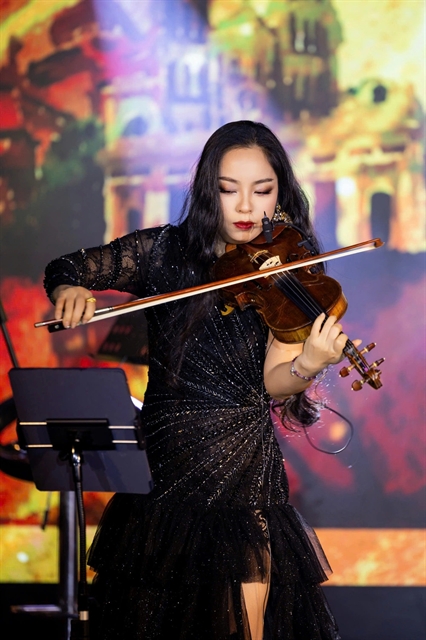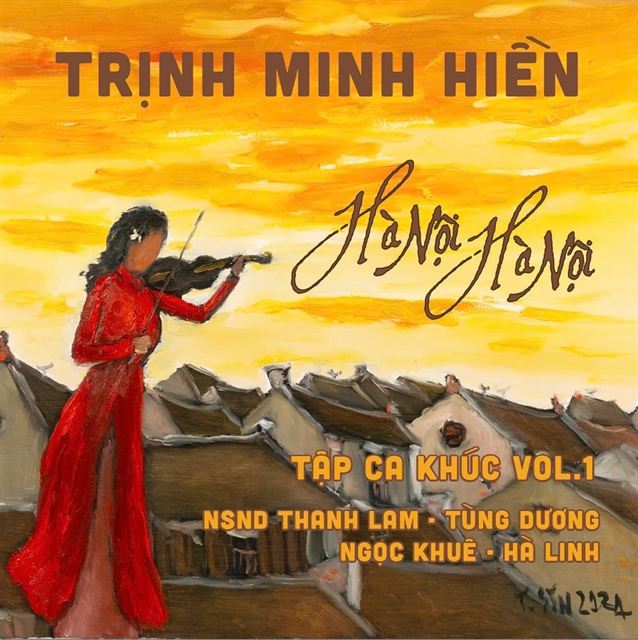Trịnh Minh Hiền talks to Bảo Linh about her debut album "Hà Nội, Hà Nội".
Widely recognised for her talent and distinctive style as a violinist and songwriter, Trịnh Minh Hiền’s music is deeply infused with national spirit and cultural resonance. She graduated from the Việt Nam National Academy of Music in 2003. From 2004 to 2020, she performed with the Việt Nam Symphony Orchestra and the Sun Symphony Orchestra, and is now the Director of Phượng Hoàng Media and Music Production Company. Hiền was honoured as one of the Outstanding Artists of 2024. Here, she talks to Bảo Linh about her work.

Violinist Trịnh Minh Hiền. Photos thethaovanhoa.vn
Inner Sanctum: After more than 20 years of composing, you finally released your debut album "Hà Nội, Hà Nội", presenting yourself as a songwriter. Why did it take so long?
I’ve been writing music for over two decades and began preparing this album more than ten years ago. But I believe that time allows for refinement. For a musician, quality outweighs quantity. It’s about introspection and choosing the right moment to share with the audience.
Inner Sanctum: You’ve established yourself as a violinist with a unique artistic path. What drives your passion for composition?
Composing lets me express my perspectives and emotions. Early on, while performing in musician Lê Minh Sơn’s band, I wrote my first song, Khép Cửa Bình Minh (Closing the Door to Dawn), in 2000. Encouraged by renowned composer Nguyễn Cường, I entered it into the "Vietnamese Songs" competition, where it reached the finals for Song of the Year. Since then, I’ve continued composing, often in quiet, solitary moments where I can explore my inner world. I’ve also adapted classical arias into Vietnamese lyrics for vocal competitions.
Inner Sanctum: Many have written about Hà Nội. Why did you choose such a well-trodden path?
My songs reflect my Hà Nội—its spirit as I experience it. I was born and raised here, and my memories of the 1980s are deeply nostalgic: mustard flower fields, nighttime power outages, and quilted coats in the winter. In Hà Nội, Hà Nội, I kept the arrangements raw—just violin, guitar, and acoustic instruments—to highlight the lyrics and the city’s atmosphere.
Musically, the album spans multiple genres: the violin ties together classical (Hà Nội, Hà Nội), Latin blues jazz (Ồ Mất Điện or Oh, Power Outage), pop (Vết Ướt or Wet Stain), alternative rock (Gọi Tôi Hà Nội or Call Me Hà Nội), and country (Khi Mình Đan Ngón Tay or When Our Fingers Intertwine). It features performances by top Vietnamese guitarists like Lê Minh Sơn, Doãn Việt Dũng, Đặng Anh Tuấn, and Hữu Hiệp, with arrangements and production by Thanh Phương, Lưu Hà An, Trần Mạnh Hùng, and Lê Minh Sơn. Notably, diva Hà Trần lends her vocals to Mẹ Ru Tàu Lá (Mother’s Lullaby of Banana Leaves).
The violin acts as a vessel of love for Hà Nội, with the album’s visuals portraying a woman in a red áo dài playing amidst historic rooftops and golden clouds—a striking embodiment of the album’s essence.

The cover of the album 'Hà Nội, Hà Nội'.
Inner Sanctum: In an era of trending music, TikTok, and electronic sounds, you’ve released a slow, introspective album. What are your hopes for it?
Today, everything moves quickly—attention spans last only a few seconds. But as the saying goes, "Hà Nội cannot be rushed". Deep emotions take time to absorb. I hope listeners will pause, reflect, and connect with Hà Nội on a deeper level. While many songs already honour the city, each generation needs new voices to continue its musical story.
Inner Sanctum: You’re a soloist, composer, and producer. How do you define yourself?
(Laughs) I’m simply an artist who pours her soul into music. Whether I’m performing or composing, I remain a multi-dimensional Trịnh Minh Hiền—always exploring and discovering.
Inner Sanctum: You’ve also redefined the violin by blending it with Vietnamese musical elements. Your album "Phượng Linh" seems to mark a new direction. Could you elaborate?
I’m always striving to innovate. Even when interpreting others’ work, I seek to bring something new. Phượng Linh represents a turning point, where I rearranged iconic Vietnamese songs for violin: Văn Cao’s Tiến Quân Ca (Marching Song), Doãn Nho’s Chiếc Khăn Piêu (The Piêu Headscarf), Phó Đức Phương’s Trên Đỉnh Phù Vân (On the Peak of Floating Clouds), Trần Tiến’s Tiếng Trống Paranưng (The Sound of Paranưng Drums), and Trịnh Công Sơn’s masterpieces like Một Cõi Đi Về (A Realm of Return), Đêm Thấy Ta Là Thác Đổ (Night Sees Me as a Waterfall), and Như Cánh Vạc Bay (Like a Flying Heron). In the age of AI and electronic music, I believe true artistry lies in human emotion and personal creativity—qualities machines cannot replicate.
Inner Sanctum: What draws a violinist like you to the beauty of Vietnamese folk music?
I love Vietnamese music for its uniqueness. Many Vietnamese artists who have succeeded internationally—like Trí Minh, Võ Vân Ánh, and Ngô Hồng Quang—incorporate traditional elements. Our folk music is rich and distinctive, and I want to assert my Vietnamese identity through my art. That’s why I embrace these traditions while adding my own innovations. Even when playing the violin, I try to infuse it with the soul of folk melodies.
This year I’ll release my second album—one that reflects my truest self, with even greater depth and complexity. VNS